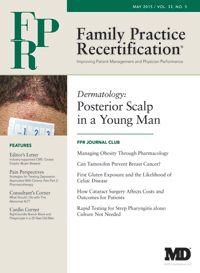Publication
Article
Family Practice Recertification
What Should I Do With This Abnormal ALT?
Author(s):
You see a 48-year-old white man for his annual examination. . The patient is overweight with a body mass index (BMI) of 32. A screening chemistry panel is normal except for an aspartate aminotransferase (AST, formerly SGOT) level of 85 U/L (normal 15-50 U/L) and an alanine aminotransferase (ALT, formerly SGPT) level of 98 U/L (normal 5-50 U/L). He says you are the first doctor he has seen in more than 10 years and does not recall the last time he had a blood test.
For more coverage on the clinical headlines and insights surrounding liver disease and more, visit our hepatitis C page.
You see a 48-year-old white man for his annual examination. He is in good health with no major medical problems and an unremarkable medical history. He states he regularly drinks one or two beers a day on the weekend but not usually on weekdays. He denies blood transfusions, tattoos or intravenous drugs. His father had diabetes. The patient is overweight with a body mass index (BMI) of 32. A screening chemistry panel is normal except for an aspartate aminotransferase (AST, formerly SGOT) level of 85 U/L (normal 15-50 U/L) and an alanine aminotransferase (ALT, formerly SGPT) level of 98 U/L (normal 5-50 U/L). He says you are the first doctor he has seen in more than 10 years and does not recall the last time he had a blood test.
What is your differential diagnosis, and what laboratory tests would you order?
Mild abnormal elevation of the aminotransferases is common in everyday practice. Most of the patients are asymptomatic and the liver test abnormalities are discovered incidentally during a routine check up or, sometimes when applying for a life insurance policy. It is important to see if these abnormalities are chronic or just of short duration and self limited. Liver test abnormalities of short duration and self limited are usually caused by medications, supplements or another underlying disease. The differential diagnosis in this patient includes nonalcoholic fatty liver disease (NAFLD)) since this is, by far, the most common cause of abnormal liver tests in the United States. Other possibilities include viral hepatitis (HBV, HCV and HEV), autoimmune hepatitis, iron storage disease, Wilson disease, alpha 1 antitrypsin deficiency and celiac sprue. Alcohol abuse is a consideration however, less likely because of the AST/ALT ratio. In alcoholic liver disease the AST is higher than the ALT.
>>> Medicine moves at breakneck speed. Get ahead with the MD Mag Newsletter.
The laboratory tests for the evaluation of this patient include: HBsAg, HB core Ab, HCV Ab, ANA, SMA, ferritin, transferring saturation, ceruloplasmin, alpha 1 antitrypsin phenotype and tissue transglutaminase.
Hepatitis serologies are negative. Results of antinuclear and smooth muscle antibody testing are negative. The serum iron value is 100 ïÂ






